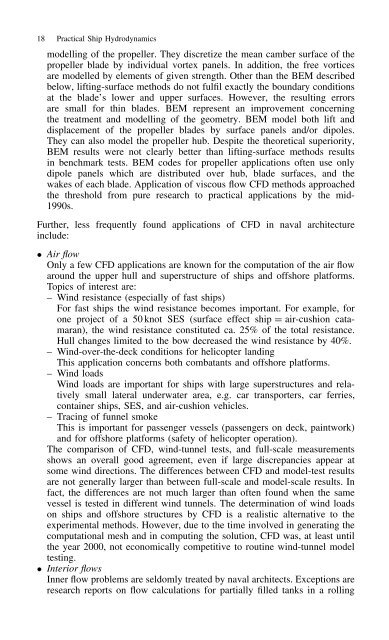Practical Ship Hydrodynamics
Practical Ship Hydrodynamics
Practical Ship Hydrodynamics
You also want an ePaper? Increase the reach of your titles
YUMPU automatically turns print PDFs into web optimized ePapers that Google loves.
18 <strong>Practical</strong> <strong>Ship</strong> <strong>Hydrodynamics</strong><br />
modelling of the propeller. They discretize the mean camber surface of the<br />
propeller blade by individual vortex panels. In addition, the free vortices<br />
are modelled by elements of given strength. Other than the BEM described<br />
below, lifting-surface methods do not fulfil exactly the boundary conditions<br />
at the blade’s lower and upper surfaces. However, the resulting errors<br />
are small for thin blades. BEM represent an improvement concerning<br />
the treatment and modelling of the geometry. BEM model both lift and<br />
displacement of the propeller blades by surface panels and/or dipoles.<br />
They can also model the propeller hub. Despite the theoretical superiority,<br />
BEM results were not clearly better than lifting-surface methods results<br />
in benchmark tests. BEM codes for propeller applications often use only<br />
dipole panels which are distributed over hub, blade surfaces, and the<br />
wakes of each blade. Application of viscous flow CFD methods approached<br />
the threshold from pure research to practical applications by the mid-<br />
1990s.<br />
Further, less frequently found applications of CFD in naval architecture<br />
include:<br />
ž Air flow<br />
Only a few CFD applications are known for the computation of the air flow<br />
around the upper hull and superstructure of ships and offshore platforms.<br />
Topics of interest are:<br />
– Wind resistance (especially of fast ships)<br />
For fast ships the wind resistance becomes important. For example, for<br />
one project of a 50 knot SES (surface effect ship D air-cushion catamaran),<br />
the wind resistance constituted ca. 25% of the total resistance.<br />
Hull changes limited to the bow decreased the wind resistance by 40%.<br />
– Wind-over-the-deck conditions for helicopter landing<br />
This application concerns both combatants and offshore platforms.<br />
– Wind loads<br />
Wind loads are important for ships with large superstructures and relatively<br />
small lateral underwater area, e.g. car transporters, car ferries,<br />
container ships, SES, and air-cushion vehicles.<br />
– Tracing of funnel smoke<br />
This is important for passenger vessels (passengers on deck, paintwork)<br />
and for offshore platforms (safety of helicopter operation).<br />
The comparison of CFD, wind-tunnel tests, and full-scale measurements<br />
shows an overall good agreement, even if large discrepancies appear at<br />
some wind directions. The differences between CFD and model-test results<br />
are not generally larger than between full-scale and model-scale results. In<br />
fact, the differences are not much larger than often found when the same<br />
vessel is tested in different wind tunnels. The determination of wind loads<br />
on ships and offshore structures by CFD is a realistic alternative to the<br />
experimental methods. However, due to the time involved in generating the<br />
computational mesh and in computing the solution, CFD was, at least until<br />
the year 2000, not economically competitive to routine wind-tunnel model<br />
testing.<br />
ž Interior flows<br />
Inner flow problems are seldomly treated by naval architects. Exceptions are<br />
research reports on flow calculations for partially filled tanks in a rolling
















